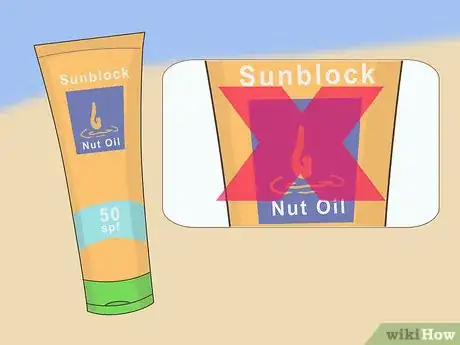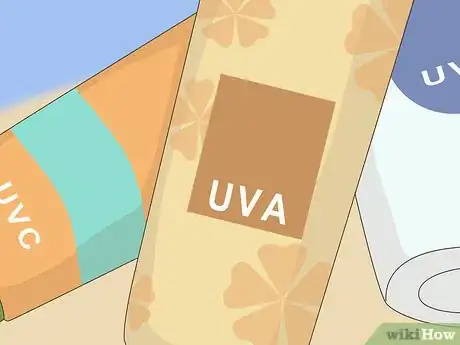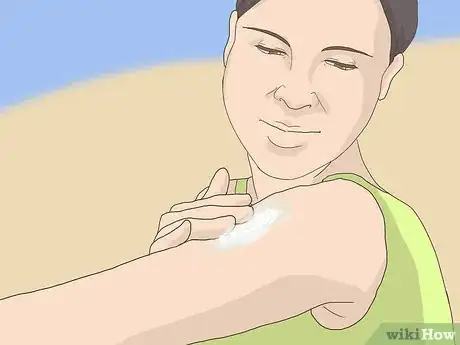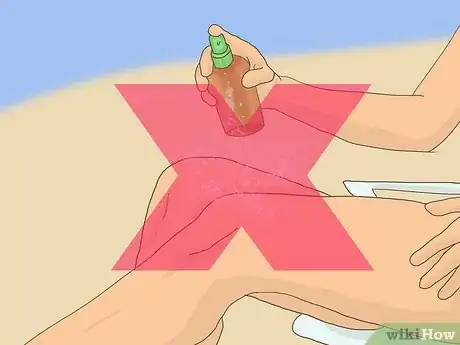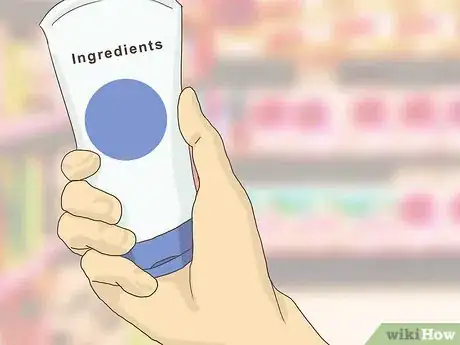This article was co-authored by Kelly Chu. Kelly is the lead makeup artist and educator of the Soyi Makeup and Hair team that is based in the San Francisco Bay Area. Soyi Makeup and Hair specializes in wedding and event makeup and hair. Over the past 5 years, the team has created bridal looks for over 800 brides in America, Asia, and Europe.
There are 16 references cited in this article, which can be found at the bottom of the page.
wikiHow marks an article as reader-approved once it receives enough positive feedback. In this case, 100% of readers who voted found the article helpful, earning it our reader-approved status.
This article has been viewed 122,232 times.
Excessive or unprotected exposure to the sun can lead to sunburn, wrinkles, skin degeneration and even skin cancer. It is important that you protect your skin from sun exposure on a daily basis to prevent damage to your skin. There are many different types of sunblock available that are designated by the sun protection factor (SPF), ingredients, resistance to water and whether they block UVA or UVB rays. Choosing the correct type of sunblock for your use and type of skin is important to maintaining healthy skin.[1]
Steps
Choosing the Specifics
-
1Choose an SPF number. The SPF number tells you what percentage of UVB rays are absorbed by the sunblock. For instance, SPF 30 absorbs approximately 97 percent of UVB rays, while SPF 50 absorbs approximately 98 percent of UVB rays, while SPF 100 can block nearly 99 percent of UVB rays. Because of this, SPFs are quite misguiding. You might think that if you spend more on a SPF 100 product, then you will be absolutely safe in the sun, when in reality, its protection against UVB rays is only 2 percent higher than that of SPF 30.[2]
- SPF only refers to blocking UVB rays, not UVA rays, and both of these can damage your skin. High SPFs have been shown to allow more UVA rays to reach your skin while not providing much better protection against UVB rays. Additionally, high SPFs do not last any longer than lower SPFs.
-
2Avoid parabens and harmful ingredients. Make sure that in protecting your skin from the sun, you aren’t exposing yourself to other harmful elements. Many sunscreens contain parabens, which may increase rates of breast cancer and facilitate the development of melanoma![3] Oxybenzone can break down skin and cause hives and other problems.[4] Retinyl palmitate can increase your risk of cancer when exposed to the sun.[5] Watch out for ingredients like those to make sure that your sunscreen isn’t doing more harm than good.
- Consider using mineral-based ingredients such as zinc oxide or titanium dioxide. These sit on top of the skin rather than being absorbed. These ingredients are able to reflect UV rays and have been shown to be safe and effective ingredients in preventing negative effects of the sun.[6] They tend to be more effective than chemical sunscreens.[7]
- You can find great mineral-based sunscreen options online here.
- If using chemicals, choose ones that protect against both UVA and UVB rays. Mexoryl SX, Mexoryl XL and Parsol 1789 are some chemicals that protect against UVA rays. Octinoxate, Octisalate and Homosalate are chemicals that protect against UVB rays. Look for a sunblock that contains these chemicals for the best overall protection from both types of rays.
- Avoid sunblocks that contain extracts of fruits or nuts. They have not been shown to block the sun and many of them can cause allergic reactions.
Advertisement -
3Look for broad spectrum sunscreen. “Broad spectrum” means that it protects from both the sun's UVA and UVB rays. UVA rays cause wrinkling and aging of the skin, while UVB rays cause sunburn, but both UVA and UVB cause skin cancer. It is best to be protected from both, however, many sunblocks only protect against UVB rays. Looking for a sunblock labeled “broad spectrum” will help you to avoid this.[8]
- You can find broad spectrum sunscreen options here.
-
4Use water-resistant sunscreen if you will be swimming. Sunblocks are no longer allowed to be labeled “waterproof” because they all wash off in water after a while. But water-resistant sunscreen can allow you to stay in the water for about 80 minutes before needing to reapply. If you plan on swimming or sweating, you will probably want a sunblock that is water-resistant. But keep in mind that it will need to be reapplied just like any other sunscreen.[9]
- You can find water-resistant sunscreen options online here.
-
5Avoid sunscreen sprays and choose creams instead. Sprays and creams are not the same. Try to avoid sunscreen sprays and choose a cream instead. With sprays, it is very easy to miss a spot and they also raise concerns about inhaling the product. Creams are more likely to ensure full coverage and you aren’t at risk of inhaling them.[10]
-
6Find additional ways to protect your skin. While a good sunblock is an important measure for protecting your skin, it is only one part of this. Some people think that as long as they apply a sunblock, they are free to go soak up the sun’s rays without any consequences. But one study showed that people using sunscreen were at a higher risk for developing melanoma.[11] This is likely due to increased time sunbathing when applying sunscreen. No sunscreen can protect from all sun rays. To truly take care of your skin, limit your sun exposure and protect yourself with clothing, hats, or umbrellas.[12]
Finding What’s Right for You
-
1Consider the amount of time you will be spending in the sun. Your sunscreen for a day at the beach versus a quick 15 minute walk doesn’t have the same requirements. For prolonged sun exposure, which you should try to avoid, make sure to use a higher SPF and to reapply often. There’s no need to go above SPF 50, but make sure it is broad spectrum to guard against all UV rays. For a lighter sunscreen, you can go as low as SPF 15 if you will only be out in the sun for a few minutes.
- To limit your sun exposure, try taking breaks. For example, if you are going to the beach for a day, spend an hour swimming and then go inside somewhere to eat lunch and reapply sunscreen.
-
2Keep in mind what activities you will be doing. Look for a water-resistant sunblock if you plan on being in the water or if you sweat a lot. It can take about 80 minutes for a water-resistant sunblock to wash off of you. A water-resistant sunblock will ensure that you have protection from the sun even when you are enveloped in water. If you won’t be exposed to water, consider other factors of your activities, such as altitude. If you are high in the mountains skiing or hiking, you will need a higher SPF because of increased sun exposure, even if it’s cold out!
- Another factor to keep in mind is your location. If you are in Mexico versus Canada, your sun exposure will be quite different! Protect yourself accordingly.
-
3Pay attention to your skin type. While all skin types benefit from sunscreen, fair skin can be especially cancer prone. If your skin is light, use a stronger sunscreen like broad spectrum SPF 50. But even if you tan easily or have very dark skin, you are still at risk for sun damage! Just because you don’t burn, doesn’t mean your skin is safe. Protect yourself by using a lower SPF.[13]
- Certain skin types are more at risk for skin cancer. Fair skin with light hair or red hair tends to be most at risk for sunburns and cancer. Be especially careful if any family members have had skin cancer. Make sure to protect yourself with appropriate sunscreen and other protective measures such as dark clothing.[14]
-
4Factor in age. This is especially important for young kids. It is not recommended that children use sunscreen sprays, sunscreens with oxybenzone, or sunscreens containing nanoparticles. Sunscreens with metal oxides such as zinc and titanium are safest. Find ones that are broad spectrum for best UV protection. Use SPF 30-50 for safe, quality protection.[15]
- For very young kids, those under 6 months old, sunscreen is not recommended. Instead protect them by keeping them in the shade, limiting their sun exposure, and having them wear a hat and protective clothing.
-
5Consider any skin sensitivities. If you know of ingredients that irritate your skin, definitely avoid those in sunscreen. If your skin is acne-prone, look for oil-free sunscreens. If you aren’t sure whether a sunscreen will irritate you, try applying a little bit on a small area before applying it to your whole body. Wait a few minutes and if any irritation occurs, you know not to use it. Additionally, fruit and nut extracts and fragrances do not improve UV blockage and can cause irritation.[16]
-
6Consider any other preventative measures you will use. This is one of the most important ways to protect your skin and will also influence your choice in sunscreen. By limiting your sun exposure, wearing protective clothing, sitting under an umbrella or tree, and wearing a hat and sunglasses, you can greatly help your skin and you will not need as strong of a sunscreen. This way you can think of sunscreen as one part of protecting your skin rather than relying on it alone. This is important for a well-rounded approach to safe skin.[17]
- Try to limit time in the sun between 10am and 4pm when the rays are strongest.
Making a Decision
-
1Go to a store. You could try a supermarket or a skincare store. You could even look at stores online. This will give you access to a wide variety of sunscreens so that you can familiarize yourself with your options.
- If you aren't sure where to start, try looking at a general marketplace such as Amazon.com. They have many sunscreens and also list the ingredients so that you can learn about them.
-
2Compare many different sunblocks. Don’t just look at the way they advertise themselves, but take the time to read through each ingredient. Be on the lookout for any potentially harmful ingredients and for helpful ones. A sunblock isn’t as good as its label; it’s as good as its ingredients. Think about which ingredients you want ahead of time so that you won’t get lost reading list after list of indecipherable chemicals. Perhaps you are looking for something with zinc oxide and no oxybenzone. Focus your search on these criteria to find the best sunblock for you.[18]
- If you find one that you like but you aren't ready to buy it, write down its name so that you can read up on it later. This can help you to make an even more informed decision.
-
3Decide which one best suits your needs. After narrowing down your search, find which one most closely aligns with your needs. There will likely be at least a couple of options that meet your criteria. Take the time to look at these more closely and factor in other requirements that you might have. Which one is water-resistant? Which one is broad spectrum? Which one has fewer chemicals? Which one costs less? Look at any aspects that are important to you and there will likely be one that stands out.[19]
- If there are a few that seem about equal, go ahead and just pick one and give it a try. If you have enough money, consider buying two so that you can try them both and see which you prefer.
-
4Make an informed decision. Whatever you do, make sure to educate yourself before you choose a sunscreen. This is an important decision that can help protect you from cancer! Don’t just choose the cheapest; try to find the product that is highest quality and best for you. This is an important preventative measure that can save you a lot of money and pain in the long run by avoiding cancer.
- If you need a sunscreen immediately and don't have time to conduct a lot of research, go for a cream that is SPF 30, broad spectrum, paraben free, with zinc oxide and no oxybenzone or retinyl palmitate.
Expert Q&A
-
QuestionIs SPF 50 much better than SPF 30?
 Kelly ChuKelly is the lead makeup artist and educator of the Soyi Makeup and Hair team that is based in the San Francisco Bay Area. Soyi Makeup and Hair specializes in wedding and event makeup and hair. Over the past 5 years, the team has created bridal looks for over 800 brides in America, Asia, and Europe.
Kelly ChuKelly is the lead makeup artist and educator of the Soyi Makeup and Hair team that is based in the San Francisco Bay Area. Soyi Makeup and Hair specializes in wedding and event makeup and hair. Over the past 5 years, the team has created bridal looks for over 800 brides in America, Asia, and Europe.
Professional Makeup Artist It depends. As a general rule of thumb, aim for at least SPF 30 for daily use, and at least SPF 50 if you'll be outside for a while, if you'll be swimming, or if you tend to sweat a lot.
It depends. As a general rule of thumb, aim for at least SPF 30 for daily use, and at least SPF 50 if you'll be outside for a while, if you'll be swimming, or if you tend to sweat a lot.
Warnings
- Sunblock is only part of the equation! To protect from skin cancer, limit your sun exposure and employ other protective measures besides sunblock.⧼thumbs_response⧽
References
- ↑ https://www.rei.com/learn/expert-advice/sunscreen.html
- ↑ https://www.theatlantic.com/health/archive/2015/06/when-it-comes-to-choosing-a-sunscreen-everyone-is-getting-burned-by-their-own-ignorance/396173/
- ↑ https://www.ncbi.nlm.nih.gov/pubmed/18484575
- ↑ http://www.huffingtonpost.ca/dr-mike-hart/does-sunscreen-cause-cancer_b_3280578.html
- ↑ https://www.ncbi.nlm.nih.gov/pubmed/16107546
- ↑ https://www.ncbi.nlm.nih.gov/pmc/articles/PMC3482794/
- ↑ Kelly Chu. Professional Makeup Artist. Expert Interview. 9 May 2019.
- ↑ https://www.theatlantic.com/health/archive/2015/06/when-it-comes-to-choosing-a-sunscreen-everyone-is-getting-burned-by-their-own-ignorance/396173/
- ↑ http://www.health.harvard.edu/cancer/how-to-choose-and-use-sunscreen
- ↑ http://www.ewg.org/sunsafety/tips-how-to-pick-a-good-sunscreen.php
- ↑ http://onlinelibrary.wiley.com/doi/10.1002/1097-0215%2820000701%2987:1%3C145::AID-IJC22%3E3.0.CO;2-3/abstract;jsessionid=9D1E0F485791649882D43933519302A5.d03t02
- ↑ http://www.cancer.org/cancer/news/features/choose-the-right-sunscreen
- ↑ http://www.nydailynews.com/life-style/health/choose-sunscreen-skin-type-article-1.2282609
- ↑ http://www.skincancer.org/prevention/are-you-at-risk/skin-types-and-at-risk-groups
- ↑ https://www.washingtonpost.com/news/parenting/wp/2016/05/26/how-to-choose-a-sunscreen-for-your-kids/
- ↑ https://www.washingtonpost.com/news/parenting/wp/2016/05/26/how-to-choose-a-sunscreen-for-your-kids/
- ↑ http://www.ewg.org/sunscreen/report/skin-cancer-on-the-rise/
- ↑ http://www.cancer.org/cancer/news/features/choose-the-right-sunscreen
- ↑ http://usatoday30.usatoday.com/news/health/2010-08-05-sunscreen05_st_N.htm

